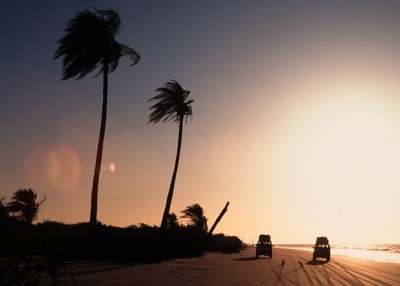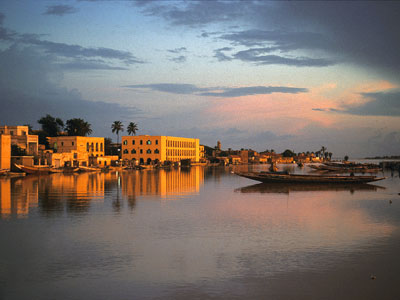PeopleSenegal has a population of 12,534,000. French is the official language but Wolof is the true lingua franca of Senegal. The Wolof are the largest ethnic group comprising 40% of the population, followed by the Peul and Toucouleur at 24%, the Serer at 15%, the Lebou at 10%, and smaller groups of Jola, Mandinka, and Soninke. There are approximately 50,000 Europeans, Lebanese, Mauritanians, and Moroccans rounding out the population with a small contingent of Vietnamese and Chinese immigrant traders.
|
Senegal is a country in western Africa south of the Senegal River, and well known for its beaches. The capital, Dakar, is situated on a peninsula with access to some of the best beaches in the country. Dakar is also home to colorful people, open-air markets, nightlife, and film, art, and music festivals. The Casamance area has rivers, mangroves, and waterways, and in northern Senegal you will find the oldest French settlement in western Africa, Saint Louis. The colonial architecture has earned it a World Heritage Designation.
Senegal boasts several national parks to preserve the beauty of the area, including the Parc National del la Laiyru Barberie, and the Parc National des Oiseaux de Djoudj, a bird watchers paradise. This park features flamingos, purple herons, and spoonbills among many others. Zinguinchor, the fourth largest town in Senegal, is a former colonial centerwith some truly majestic houses; a fascinating place for both historians and architects. |
Geography
Senegal is located in West Africa with its capital on the Cape Verde peninsula. The landscape features sandy, rolling plains with foothills in the southeast. The northern border is the Senegal River, and other rivers include the Casamance and Gambia. The climate is tropical with dry and humid seasons. The annual rainfall is 23.6 inches (600mm) and falls mostly during June through October. Around the coastal areas the average maximum temperature is 80.6 degrees F (27 degrees C), but the interior gets much hotter with maximum temperatures there reaching up to 129.2 degrees F (51 degrees C).
Famous AttractionDakar is the capital of Senegal and is well known for its beaches and nightlife. Stroll the open-air markets by day and enjoy music and dancing by night. Touba is the holy city of Mouridism and the burial place of its founder, Sheik Aamader Bamba Mbakke. A large mosque was built next to his burial site, completed in 1963.
Saint Louis is a hallmark of colonial architecture, and home of the Djoudj National Bird Sanctuary. About 3 million migrating birds visit it each year. Truly, no trip to Senegal is complete without a visit to Lac Rose. This lake northeast of Dakar is so named because the water is actually pink. It has a high salt content, comparable to that of the Dead Sea and is frequently the end point of the Dakar Rally. |
HistoryLike most African countries, there is evidence of human habitation since prehistoric times. Senegal is historically a part of the Empire of Ghana, founded by the Emperor Tukulor. Islam appears in the 11th century and eastern empires throughout the 13th and 14th centuries influenced the country. This was also the time of the Jolof Empire, which had an advanced political system. The society was hierarchical and patriarchal but women of the upper classes could be quite influential in government.
By the 15th century the Portuguese, Dutch, and British were all competing for control of West Africa. Senegal became a French possession in 1677, and the island of Goree near Dakar was a central administrative office for the slave trade. The French had spread to the interior by the 1850's. French colonial rule continued well into the 20th century, but in January of 1959 Senegal and French Sudan merged into the Mali Federation. They received independence on June 20, 1960. In August of that year the Federation broke up and Senegal became an independent nation with Leopold Senghor as the first president. In February of 1982 Senegal joined with Gambia to become Sengambia but that union dissolved in 1989. The Casamance region still has a contingent of separatists., but despite political unrest, Senegal has a deep commitment to democracy. In 1999 Abdoulaye Wade was elected president on a promise of peace. |
NightlifeDakar is the place to go for nightlife, with many clubs and bars that feature live music. Most clubs are open very late, and there is a casino en route to N'Gor. Of course there are restaurants that serve fine food, and cinemas showing mostly French films. The Daniel Sorano National Theatre is a wonderful venue as well. But while the nightlife of Dakar is well known, insiders know that the best of it doesn't really begin until after midnight.
|
Culture
French is the official national language but few actually speak it. Native languages are far more common, with Wolof the most prevalent. Most people belong to Islam but there are Christian churches as well. The Ba'hai faith has been growing ever since its founder urged followers to go there. Along with these major religions, many people still believe in the ancient animism traditions.
The Sengalese are famous for their music and their arts and crafts. Their musical traditions are the most well known of the west African nations, due in large part to the musician Youssou Ndor. Many differing cultures within the country all contribute to folk music and modern music in Senegal. Currently, hip-hop, imported from the United States, is a very popular medium.
The Sengalese are famous for their music and their arts and crafts. Their musical traditions are the most well known of the west African nations, due in large part to the musician Youssou Ndor. Many differing cultures within the country all contribute to folk music and modern music in Senegal. Currently, hip-hop, imported from the United States, is a very popular medium.
CuisineThieboudienne is the national dish of Senegal, comprised of fish, rice, tomato sauce, onions, and peanut oil. It gets its name from Wolof and it means simply rice and fish. Rice is a central component of most Senagalese cuisine. As a peanut producing country, peanuts and peanut oil also contribute heavily to the Senagalese diet. Of course, having a seacoast, you would expect to find many seafood dishes as well. In fact, you can find most everything in Senegal, with the possible exception of pork because of the heavily Islamic population. Other dishes include Yassa, which is chicken cooked with lemon and onion; Somba, a milky rice soup; and Dibi, a lamb dish. From the French, the Sengalese have also developed a love of fondue.
|
Qunar







